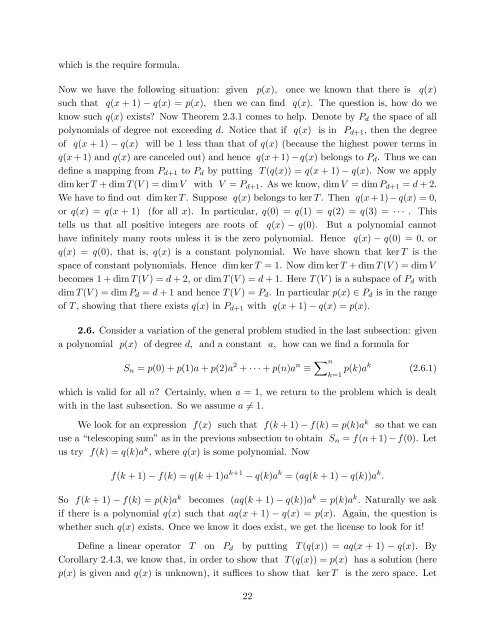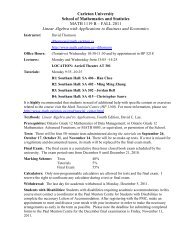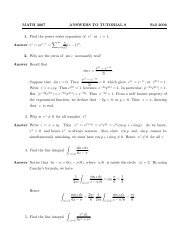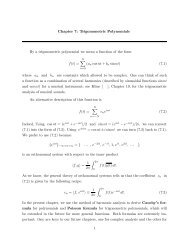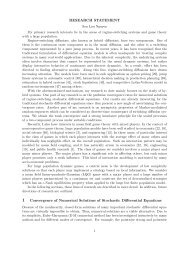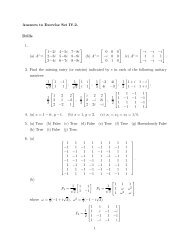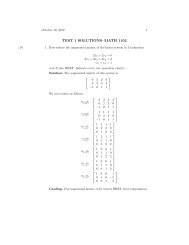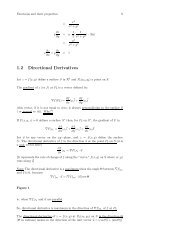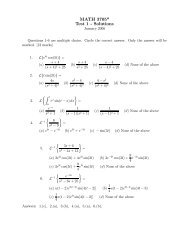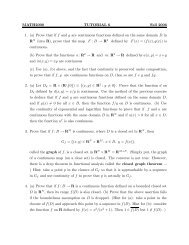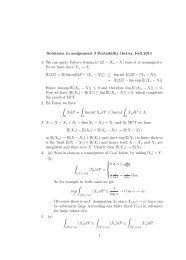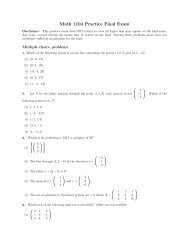CHAPTER II DIMENSION In the present chapter we investigate ...
CHAPTER II DIMENSION In the present chapter we investigate ...
CHAPTER II DIMENSION In the present chapter we investigate ...
Create successful ePaper yourself
Turn your PDF publications into a flip-book with our unique Google optimized e-Paper software.
which is <strong>the</strong> require formula.<br />
Now <strong>we</strong> have <strong>the</strong> following situation: given p(x), once <strong>we</strong> known that <strong>the</strong>re is q(x)<br />
such that q(x + 1) − q(x) = p(x), <strong>the</strong>n <strong>we</strong> can find q(x). The question is, how do <strong>we</strong><br />
know such q(x) exists? Now Theorem 2.3.1 comes to help. Denote by Pd <strong>the</strong> space of all<br />
polynomials of degree not exceeding d. Notice that if q(x) is in Pd+ 1, <strong>the</strong>n <strong>the</strong> degree<br />
of q(x + 1) − q(x) will be 1 less than that of q(x) (because <strong>the</strong> highest po<strong>we</strong>r terms in<br />
q(x + 1) and q(x) are canceled out) and hence q(x + 1) − q(x) belongs to Pd. Thus <strong>we</strong> can<br />
define a mapping from Pd+ 1 to Pd by putting T (q(x)) = q(x + 1) − q(x). Now <strong>we</strong> apply<br />
dim ker T + dim T (V ) = dim V with V = Pd+ 1. As <strong>we</strong> know, dim V = dim Pd+ 1 = d + 2.<br />
We have to find out dim ker T . Suppose q(x) belongs to ker T . Then q(x + 1) − q(x) = 0,<br />
or q(x) = q(x + 1) (for all x). <strong>In</strong> particular, q(0) = q(1) = q(2) = q(3) = · · · . This<br />
tells us that all positive integers are roots of q(x) − q(0). But a polynomial cannot<br />
have infinitely many roots unless it is <strong>the</strong> zero polynomial. Hence q(x) − q(0) = 0, or<br />
q(x) = q(0), that is, q(x) is a constant polynomial. We have shown that ker T is <strong>the</strong><br />
space of constant polynomials. Hence dim ker T = 1. Now dim ker T + dim T (V ) = dim V<br />
becomes 1 + dim T (V ) = d + 2, or dim T (V ) = d + 1. Here T (V ) is a subspace of Pd with<br />
dim T (V ) = dim Pd = d + 1 and hence T (V ) = Pd. <strong>In</strong> particular p(x) ∈ Pd is in <strong>the</strong> range<br />
of T , showing that <strong>the</strong>re exists q(x) in Pd+ 1 with q(x + 1) − q(x) = p(x).<br />
2.6. Consider a variation of <strong>the</strong> general problem studied in <strong>the</strong> last subsection: given<br />
a polynomial p(x) of degree d, and a constant a, how can <strong>we</strong> find a formula for<br />
Sn = p(0) + p(1)a + p(2)a 2 + · · · + p(n)a n ≡ n<br />
k= 1 p(k)ak<br />
(2.6.1)<br />
which is valid for all n? Certainly, when a = 1, <strong>we</strong> return to <strong>the</strong> problem which is dealt<br />
with in <strong>the</strong> last subsection. So <strong>we</strong> assume a = 1.<br />
We look for an expression f(x) such that f(k + 1) − f(k) = p(k)a k so that <strong>we</strong> can<br />
use a “telescoping sum” as in <strong>the</strong> previous subsection to obtain Sn = f(n + 1) − f(0). Let<br />
us try f(k) = q(k)a k , where q(x) is some polynomial. Now<br />
f(k + 1) − f(k) = q(k + 1)a k+ 1 − q(k)a k = (aq(k + 1) − q(k))a k .<br />
So f(k + 1) − f(k) = p(k)a k becomes (aq(k + 1) − q(k))a k = p(k)a k . Naturally <strong>we</strong> ask<br />
if <strong>the</strong>re is a polynomial q(x) such that aq(x + 1) − q(x) = p(x). Again, <strong>the</strong> question is<br />
whe<strong>the</strong>r such q(x) exists. Once <strong>we</strong> know it does exist, <strong>we</strong> get <strong>the</strong> license to look for it!<br />
Define a linear operator T on Pd by putting T (q(x)) = aq(x + 1) − q(x). By<br />
Corollary 2.4.3, <strong>we</strong> know that, in order to show that T (q(x)) = p(x) has a solution (here<br />
p(x) is given and q(x) is unknown), it suffices to show that ker T is <strong>the</strong> zero space. Let<br />
22


